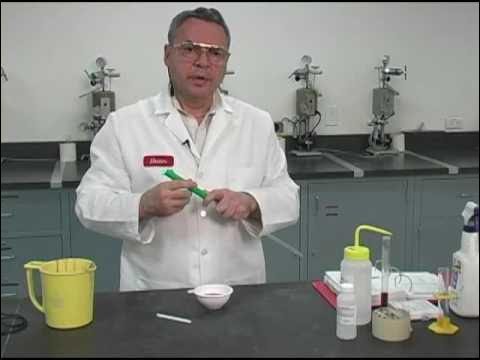AL 2.3 | Diluição de soluções
Summary
TLDRIn this video, the process of diluting a potassium dichromate solution is demonstrated. Starting with a 0.020 mol/dm³ concentration, the solution is transferred using a 20 ml volumetric pipette into a 500 ml volumetric flask. After careful addition of distilled water and mixing, the final concentration is calculated as 8.0 x 10⁻⁴ mol/dm³. The video emphasizes the importance of precision in handling the equipment and explains how the dilution factor of 25 is derived. The practical activity aids in understanding solution dilution, reinforcing laboratory skills for future experiments.
Takeaways
- 😀 Dilution of potassium dichromate solution is the focus of the activity.
- 😀 To prepare the solution, you need to use a 20 ml volumetric pipette and a 500 ml volumetric flask.
- 😀 Before transferring the solution, it's important to practice using the pipette and bulb with water.
- 😀 When transferring the solution, ensure the exact volume reaches the mark on the flask.
- 😀 A small amount of solution may remain in the pipette, but do not attempt to remove it, as the pipette is calibrated for this.
- 😀 After transferring the solution, add distilled water to reach the final volume.
- 😀 The final solution must be gently agitated to ensure even mixing.
- 😀 The concentration of the solution changes due to dilution, and this is visually noticeable through a change in color.
- 😀 To calculate the final concentration, the formula used is: C1 × V1 = C2 × V2.
- 😀 In this case, the initial concentration (C1) was 0.020 mol/L, and the final volume was 500 ml.
- 😀 The final concentration of the solution is found to be 8.0 x 10^-4 mol/L, and the dilution factor is 25.
Q & A
What is the first step in the dilution process?
-The first step is to prepare a 500 ml solution of potassium dichromate with a concentration of 0.020 mol per dm³, if you haven't already done so in the previous activity.
What equipment is used for the dilution process?
-The dilution process uses a 20 ml volumetric pipette and a 500 ml volumetric flask.
Why should you rinse the pipette and pumpette with water before using them?
-Rinsing the pipette and pumpette with water ensures that no contaminants or residual chemicals affect the accuracy of the dilution.
What is the purpose of transferring 20 ml of potassium dichromate solution into the 500 ml volumetric flask?
-The purpose of transferring 20 ml of the potassium dichromate solution is to dilute it with water to achieve the desired final concentration.
What should you do if a small amount of solution remains in the pipette after transferring it?
-You should not try to remove the remaining solution from the pipette, as the pipette is calibrated to account for this small residue.
What happens after the 20 ml of solution is transferred into the volumetric flask?
-After transferring the solution, you add distilled water to the flask until the solution reaches the reference mark, then shake it gently to mix thoroughly.
How do you calculate the final concentration of the diluted solution?
-The final concentration can be calculated using the formula: initial concentration × initial volume = final concentration × final volume. In this case, 0.020 mol/dm³ × 0.020 L = final concentration × 0.500 L, resulting in a final concentration of 8.0 x 10⁻⁴ mol/dm³.
What is the dilution factor in this process?
-The dilution factor is 25, calculated by dividing the initial concentration (0.020 mol/dm³) by the final concentration (8.0 x 10⁻⁴ mol/dm³).
Why is it important to note that the number of moles remains constant during the dilution?
-It is important because when the solution is diluted, the number of moles of the solute stays the same; only the volume changes, which results in a decrease in concentration.
What does the change in color of the potassium dichromate solution indicate?
-The change in color is an intuitive visual cue that indicates the concentration has been altered, confirming the dilution process is working as expected.
Outlines

This section is available to paid users only. Please upgrade to access this part.
Upgrade NowMindmap

This section is available to paid users only. Please upgrade to access this part.
Upgrade NowKeywords

This section is available to paid users only. Please upgrade to access this part.
Upgrade NowHighlights

This section is available to paid users only. Please upgrade to access this part.
Upgrade NowTranscripts

This section is available to paid users only. Please upgrade to access this part.
Upgrade NowBrowse More Related Video
5.0 / 5 (0 votes)





